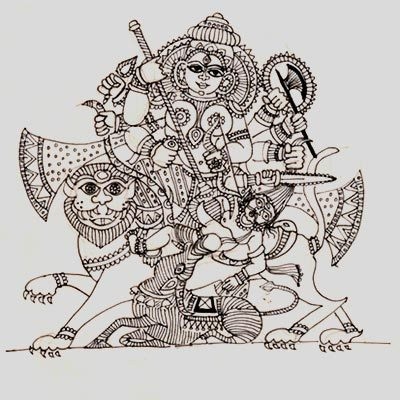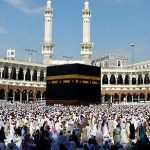Goddess with yellow face
Published on 24th September, 2017, in The Telegraph
Durga Puja is here and the whole of eastern India is all set for a week of festive fun. Could you tell us the most popular story of how Goddess Durga was created?
The gods were unable to kill an asura who had obtained a boon that he could not be killed by gods. So they were advised to release their individual powers and combine them to create a new creature, which turned out to be a goddess with many arms. Carrying the weapons of all the gods, she defeated the asura easily, for the asura who had sought protection from the gods had forgotten to ask protection from the goddess. This goddess is called Durga. She embodies “that with which we fortify (durg means fort) ourselves”.
Is Durga the same as Sati, Shiva’s wife? Who then is Kali?
In Hindu mythology, nature is the Goddess and the human mind is God. Goddess and God take many forms. Wild, untamed nature is Kali. Domesticated nature is Gauri. Nature who enchants Shiva and makes him give up his hermit ways and become a householder takes the form of Sati first and then Parvati.
Read Also:Ghosts look for Home : Dr Devdutt Pattnaik
Is Shakti another name for Durga? There is a difference, you have written….
At a raw level, yes. At a refined level, no. Shakti refers to our inner strength. Durga refers to strength we obtain from outside — weapons, instruments, fortresses, status, laws.
Why does Durga come to her paternal home with her children during autumn?
This is an eastern tradition, where the Goddess is seen as the daughter of the local king who is married to the distant ascetic Shiva. Though a princess, she chose to marry the hermit-god to make him a householder, for when Shiva marries and participates in household life, droughts and diseases come to an end, and the world is filled with auspiciousness and abundance (mangalyam, in Sanskrit).
After the rains, when the harvest comes, she visits her father’s house, where she is indulged with food and fun, before she returns to the house of the hermit-husband who is innocent and does not know how to do household chores or carry the burden of the household, which is why he is called Bholenath.
But why is she riding a lion and killing a demon?
Lion is the symbol of kings. Durga is the patron deity of kings. And so the worship of lion-riding Durga embodies royal power. Without her, a king is nobody. The demon embodies the king’s enemies who have their eye on the king’s throne, known as singh-asana, or the seat of the lion. It is a reminder to the king that the Goddess who gives him royal status can abandon him if he abandons dharma. For he is the lion, and she rides the lion.
What is Mahishasura’s story?
The demon who Durga kills is called Mahishasura as he is a shape-shifter and he is killed when he takes the form of a wild buffalo (mahisha).
What is the significance of Durga’s yellow complexion as seen on most idols in Bengal, as you have mentioned in your book 7 Secrets of the Goddess?
The yellow colour reminds us that the Goddess is identified as haldi-mukhi or turmeric-faced. This makes her radiant as the sun. It connects her with gold, with the harvest, with lions, and all things mangala. This has to be contrasted with the white Shiva and the black Vishnu. Eastern India is greatly influenced by Jagannath of Puri, whose sister Subhadra is yellow-faced, drawing attention to an old temple mythology according to which Durga is Shiva’s consort and Vishnu’s sister.
Read Also:A Purana for Muslims: By Devdutt Pattanaik
Why is this puja called Akalbodhan?
Akalbodhan is based on a myth found in the Krittibasa Ramayana that is popular in Bengal. Traditionally, Durga was worshipped in spring, before the rains. This is Vasant-nava-ratri. But Ram invoked Durga after the rains, while launching an attack on Lanka. This “untimely invocation” or Akalbodhan led to the worship of Durga in autumn as Sharad-nava-ratri.
Why is Durga Puja celebrated in Bengal, Assam and Odisha with much bigger fanfare than in other parts of India?
Durga Puja is essentially a festival of kings and celebrated in all royal households across India. In Bengal, when kings were abolished, zamindars or landlord, or rather tax-collectors, appointed by the British functioned like kings and started worshipping Durga in their courtyards (bari, in Bengali). Image-building would start when the Rath-yatra would conclude in Puri’s Jagannath temple and the image made of riverbank clay would be dissolved in the river after the autumn worship, to remind us of the ephemeral nature of the seasons, and life. This festival became popular in the 18th century as a way of impressing the new overlords of the region, the East India Company. Eventually it became institutionalised and democratised as part of the Freedom Movement that sought to mobilise public participation in the society and break traditional boundaries of caste. Another theory is that zamindars adopted it from the Gosani yatras of the Thakurani (local goddess) shrines that surround the Puri Jagannath shrine.
— Samhita Chakraborty
Religion World is one and only indian website to give information of all religions. We are dedicated to present the religions. You can send any info, news, engagements and advice to us on – religionworldin@gmail.com – or you can WhatsApp on – 9717000666 – we are also on Twitter, Facebook and Youtube.









